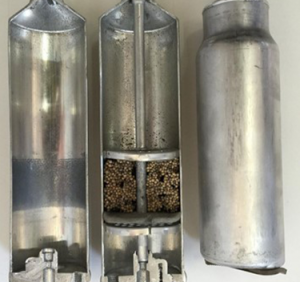

- It provides storage for the air conditioning refrigerant and lubricating oil
- It filters non-condensable oil, liquid and debris from the air conditioning system
- It contains small pellets called desiccant (drying agent) to trap and absorb moisture. (The small pellets shown in middle of the cutaway section)
Note that moisture is the most harmful enemy of the air conditioning system. If any moisture is in the system, it will combine with the refrigerant to form hydrochloric acid which is extremely corrosive to metal components. It can also degrade the lubricating oil in the system necessary to keep the compressor and other components operating smoothly. Too much moisture can also cause compressor failures in extreme circumstances.
Much like the engine oil filter on your car, the air conditioning system’s receiver/drier (filter) should be changed regularly. It is recommended that the drier be changed every 2 years.
Over time the desiccant gets saturated and cannot absorb any more moisture allowing it to flow through the system causing component failure (seized compressor). Changing the receiver/drier involves recovering and recharging (known as re-gassing) the system.
Replacing the receiver/drier will ensure better performance and prolong the lifespan of your vehicle’s air conditioning components.
Prices for receiver/driers start from $12 + service/fitting. A lot cheaper than replacing a seized compressor and keeps your car’s air conditioning operating at its best.
- confirm any system issues or concerns
- visually inspect all system components
- check the refrigerant charge level
- pressure test the air conditioning system for leaks
- add the correct refrigerant charge to system and check performance
- check operation of all components including fans, compressor/clutch and controls
- check system operating pressures and temperatures
- prepare a list of items requiring service, replacement or rectification
- replace serviceable items including drier, service valves, accessible O-rings and cabin filter (where applicable)
- retest system for pressures and temperatures

